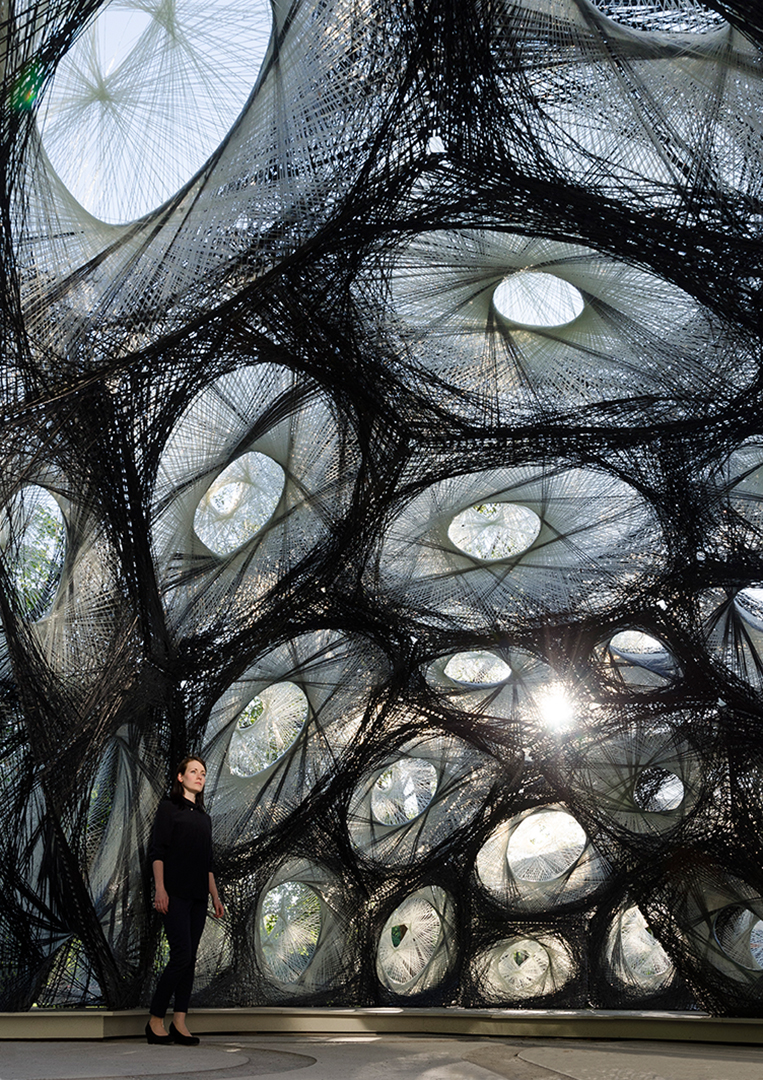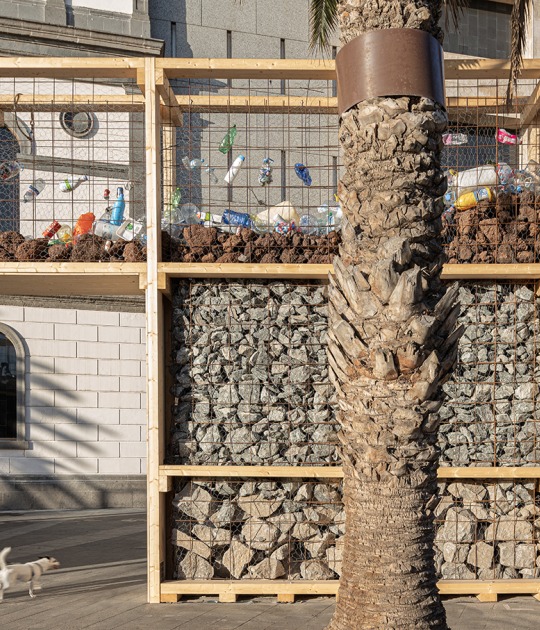The Institute of Building Structures and Structural Design (ITKE) of the University of Stuttgart and the Institute for Computational Design (ICD) have constructed another bionic research pavilion. The project is part of a successful series of research pavilions that showcase the potential of novel design, simulation, and fabrication processes in architecture. The project was planned and constructed within one and a half years by students and researchers within a multi-disciplinary team of architects, engineers, and biologists.
The focus of the project is a parallel bottom-up design strategy for the biomimetic investigation of natural fiber composite shells and the development of novel robotic fabrication methods for fiber-reinforced polymer structures. The aim was the development of a winding technique for modular, double-layered fiber composite structures, which reduces the required formwork to a minimum while maintaining a large degree of geometric freedom.
Therefore, functional principles of natural lightweight structures were analyzed and abstracted in cooperation with the University of Tübingen and the Karlsruhe Institute of Technology. Through the development of a custom robotic fabrication method, these principles were transferred into a modular prototype pavilion.

ICD ITKE Research Pavilion 2013-14. Photographs by ICD/ITKE University Stuttgart
BIOMIMETIC INVESTIGATION
During the investigation, the Elytron, a protective shell for beetles’ wings and abdomen, has proved to be a suitable role model for highly material-efficient construction. The performance of these lightweight structures relies on the geometric morphology of a double-layered system and the mechanical properties of the natural fiber composite. The anisotropic characteristic of this material, which consists of chitin fibers embedded in a protein matrix, allows for locally differentiated material properties.

ICD ITKE Research Pavilion 2013-14. Photographs by ICD/ITKE University Stuttgart.
In cooperation with the ANKA Synchrotron Radiation Facility and the Institute for Photon Science and Synchrotron Radiation at the Karlsruhe Institute of Technology (KIT), high-resolution 3D models of various beetle elytra were extracted through micro-computed tomography. Together with SEM scans from the University of Tübingen, this enabled an analysis of the intricate internal structures of the beetle shell. The Elytra morphology is based on a double-layered structure that is connected by column-like doubly curved support elements, the trabeculae. The fiber layout within a trabecula merges the upper and lower shell segments with continuous fibers. The distribution and geometric articulation of the trabecula are highly differentiated throughout the beetle shell. Through comparative studies of multiple flying beetle species, the underlying structural principles could be identified and translated into design rules for structural morphologies.

ICD ITKE Research Pavilion 2013-14. Photographs by ICD/ITKE University Stuttgart.
MATERIAL AND STRUCTURAL LOGIC
Based on the differentiated trabeculae morphology and the individual fiber arrangements, a double-layered modular system was generated for implementation in an architectural prototype. Through the development of computational design and simulation tools, both the robotic fabrication characteristics and the abstracted biomimetic principles could be simultaneously integrated into the design process.
Glass and carbon fiber reinforced polymers were chosen as building materials, due to their high-performance qualities (high strength-to-weight ratio) and the potential to generate differentiated material properties through fiber placement variation. Together with their unrestrained moldability, fiber-reinforced polymers are suitable for implementing complex geometries and material organizations of abstracted natural construction principles. Conventional fabrication methods for fiber composite elements require a mold to define form. However, this method proves to be unsuitable for transferring natural construction principles into architectural applications since they usually involve unique elements that would require extensive formwork and prohibitively complex molds.

ICD ITKE Research Pavilion 2013-14. Photographs Roland Halbe / ICD/ITKE University Stuttgart.
ROBOTIC WINDING PROCESS
For the fabrication of the geometrically unique, double-curved modules a robotic coreless winding method was developed, which uses two collaborating6-axis industrial robots to wind fibers between two custom-made steel frame effectors held by the robots. While the effectors define the edges of each component, the final geometry emerges through the interaction of the subsequently laid fibers. The fibers are at first linearly tensioned between the two effector frames. The subsequently wound fibers lie on and tension each other which results in a reciprocal deformation. This fiber–fiber interaction generates doubly curved surfaces from initially straight deposited fiber connections. The order in which the resin-impregnated fiber bundles (rovings) are wound onto the effectors is decisive for this process and is described through the winding syntax. The specific sequence of fiber winding allows for control of the layout of every individual fiber leading to a material-driven design process. These reciprocities between material, form, structure, and fabrication are defined through the winding syntax which therefore becomes an integral part of the computational design tool.

ICD ITKE Research Pavilion 2013-14. Photographs by ICD/ITKE University Stuttgart.
The effectors are adjustable to various component geometries, leading to only one reconfigurable tool setup for all 36 elements. Coreless filament winding not only saves substantial resources through the needlessness of individual molds but in itself is a very material-efficient fabrication process since there is no waste or cut-off pieces.
The specific robotic fabrication process includes the winding of 6 individual layers of glass and carbon fibers. A first glass fiber layer defines the element's geometry and serves as the formwork for the subsequent carbon fiber layers. These carbon fiber layers act as structural reinforcement and are individually varied through the fiber's anisotropic arrangement. The individual layout of the carbon fibers is defined by the forces acting on each component which are derived from FE Analysis of the global structure. The generated winding syntax is transferred to the robots and allows the automatic winding of the 6 fiber layers.

ICD ITKE Research Pavilion 2013-14. Photographs Roland Halbe / ICD/ITKE University Stuttgart.
BIOMIMETIC PROTOTYPE
In total 36 individual elements were fabricated, whose geometries are based on structural principles abstracted from the beetle elytra. Each of them has an individual fiber layout which results in a material-efficient load-bearing system. The biggest element has a 2.6 m diameter with a weight of only 24.1 kg. The research pavilion covers a total area of 50 m² and a volume of 122 m³ with a weight of 593 kg.

ICD ITKE Research Pavilion 2013-14. Photographs by ICD/ITKE University Stuttgart.
The overall geometry reacts to site-specific conditions of the public space around the university building near the park. At the same time, it demonstrates the morphologic adaptability of the system, by generating more complex spatial arrangements than a simple shell structure. Altogether the research pavilion shows how the computational synthesis of biological structural principles and the complex reciprocities between material, form, and robotic fabrication can lead to the generation of innovative fiber composite construction methods. At the same time, the multidisciplinary research approach not only leads to performative and material-efficient lightweight constructions, it also explores novel spatial qualities and expands the tectonic possibilities of architecture.
The project is part of an ongoing program investigating how natural lightweight structures can be recreated using architecture. Each pavilion is researched and constructed over 18 months.















































